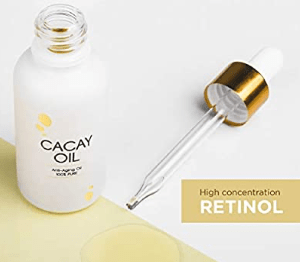Affiliate Disclosure: This blog may receive a small commission at no extra cost to you, for purchases made via affiliate links. If you decide to support our blog in this way, I thank you!
 When I was 19 years old, I had a bout of acne. The dermatologist prescribed Retin A, also know as Retinoic Acid or Tretinoin. It cleared my skin but not without major irritation and peeling. I was studying Spanish in Spain that summer, and little did I know that Retin A makes your skin more vulnerable to the sun and you absolutely need to wear sunscreen when you’re using it. I ignorantly basked in the hot Spanish sun, scorching my poor face.
When I was 19 years old, I had a bout of acne. The dermatologist prescribed Retin A, also know as Retinoic Acid or Tretinoin. It cleared my skin but not without major irritation and peeling. I was studying Spanish in Spain that summer, and little did I know that Retin A makes your skin more vulnerable to the sun and you absolutely need to wear sunscreen when you’re using it. I ignorantly basked in the hot Spanish sun, scorching my poor face.
As it turned out, Retin A began to be prescribed for anti-aging as well, because the improved effects were noticeable. The skin was brighter, more refined and firmer.
Since I’d already gotten used to it, I continued to use it for many years. Now I will occasionally use Retinol, which is a lower-strength version of Retina A. I prefer to use a cruelty-free brand, of which there are fortunately many and of course now I wear a strong sunscreen.
The benefits of using some form of vitamin A on our skin are well-known: it renews skin on a cellular level, brightens the surface while it encourages the growth of new collagen. It strengthens elastin, which is the scaffolding of the skin.
Some people cannot tolerate the harshness of Retin A or even the weaker Retinol produts. It takes a long while to get used to these products and in the meantime your skin could peel and get inflamed.
Here’s where nature steps up with the following 3 facial oils and extracts that have naturally-occurring vitamin A. I use these more often than any other form of vitamin A cream because they are much less irritating and can double as a moisturizer overnight as they work on renewing skin cells.
BAKUCHIOL:
 Bakuchiol is an extract from the seeds and leaves of the Psoralea Corylifolia plant. It is known more commonly as Babchi, and grows throughout India and parts of South America.
Bakuchiol is an extract from the seeds and leaves of the Psoralea Corylifolia plant. It is known more commonly as Babchi, and grows throughout India and parts of South America.
The British Journal of Dermatology in this study compared Bakuchiol with Retinol at 5 % applied twice a day. After 12 weeks they found that Bakuchiol was as effective as retinol for fine lines, wrinkles, texture, and brightness of the skin.
People tolerated it well and experienced more even pigmentation, smoother texture, better color and improved firmness. It is also good to use on the neck and chest without causing irritation.
Here are a few highly-rated products with Bakuchiol.
Click the highlighted links below if you’d like to give them a try.

Beyond Retinol by IMAGINE Dermatology


CACAY OIL:
 Caryodendron orinocense, commonly known as cacay is an evergreen tree belonging to the family Euphorbiaceae. The oil is derived from the seed of the plant. The chemical composition of cacay is rich in linoleic acid, which is a fatty acid that is extra moisturizing. Cacay oil is very high in antioxidants: squalene is one such antioxidant that it contains, Tocopherol (vitamin e) is another antioxidant that is plentiful in Cacay oil.
Caryodendron orinocense, commonly known as cacay is an evergreen tree belonging to the family Euphorbiaceae. The oil is derived from the seed of the plant. The chemical composition of cacay is rich in linoleic acid, which is a fatty acid that is extra moisturizing. Cacay oil is very high in antioxidants: squalene is one such antioxidant that it contains, Tocopherol (vitamin e) is another antioxidant that is plentiful in Cacay oil.
There aren’t a lot of independent studies done on Cacay oil, from what I can see, but I don’t think that means it’s not effective; it just means it hasn’t been studied. However, there is a lot of anecdotal evidence. People report that it makes their skin look as good as using a retinol product, but it is natural and it doesn’t cause irritation. I’ve used it and I do like the way it refines my skin and improves the color. I rotate between these three oils. Cacay is the most moisturizing of the three choices, however at first you might notice peeling due to the retinol action. You need to get through this period as with any retinol, but it’s much less severe. I like my skin to peel; it means the cells are acting younger and turning over faster.
These are some recommended Cacay Oil products, if you’re interested in trying them.



ROSEHIP SEED OIL
 Rosehip Seed Oil is my personal favorite out of these 3 retinol alternatives, but they are all effective and everyone’s skin is different. Rosehip Seed Oil (sometimes also called Rosehip Oil) is a natural source of retinol as well as vitamin C. It is a rich orangey color and smells like a vitamin C serum to me. I use it at night and in the morning my pores are refined and my skin is glowing. It is again rich in fatty acids which are nourishing to the skin. It might feel like it’s drying to the skin but that’s just the retinol doing its thing.
Rosehip Seed Oil is my personal favorite out of these 3 retinol alternatives, but they are all effective and everyone’s skin is different. Rosehip Seed Oil (sometimes also called Rosehip Oil) is a natural source of retinol as well as vitamin C. It is a rich orangey color and smells like a vitamin C serum to me. I use it at night and in the morning my pores are refined and my skin is glowing. It is again rich in fatty acids which are nourishing to the skin. It might feel like it’s drying to the skin but that’s just the retinol doing its thing.
Research on rosehips show they de-activate free radicals that can cause DNA damage. This paper from the NIH states: they are known to have a high level of antioxidant and antimicrobial action. Their antioxidant activity is due to their content in polyphenols, vitamins C, E, B and carotenoids and these compounds may have synergistic effects. Rose hips also have an anti-inflammatory action, as well as anti-diabetic and anticancer effects
Use the links below if you’d like to try Rosehip Seed Oil, or find your favorite at your local organic grocery.



RECOMMENDATIONS WHEN USING NATURAL RETINOL ALTERNATIVES:
*Only Use at Night
*Use just 3-4 drops
*Apply to damp skin
*Rinse skin in morning, but do not cleanse with soap
*Use it alone or over another skin active such as Retin A, Niacinamide, or Vitamin C.
For a review of another natural, effective skin topical, see my post on The Ordinary’s Resveratrol 3% + Ferulic Acid 3% serum.
Leave comments below!





2 thoughts on “Repair Sun Damage with 3 Natural Alternatives to Retinol”
I am loving this blog! Thank you so much! xo
Thank you! I’m so glad you’re enjoying it! If you have any suggestions feel free to let me know :-))